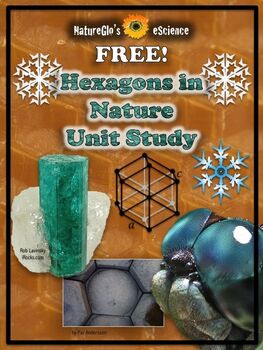FREE! Math Art Hexagons Thematic Unit Plan PowerPoint | Distance Learning
1,162 Downloads
Natureglo's eScience
147 Followers
Grade Levels
3rd - 8th, Homeschool
Subjects
Resource Type
Standards
CCSS3.G.A.1
CCSS4.G.A.1
CCSS4.G.A.2
CCSS4.G.A.3
CCSS5.G.B.4
Formats Included
- Zip
- Internet Activities
Pages
24 pages
Natureglo's eScience
147 Followers
Compatible with Digital Devices
The Teacher-Author has indicated that this resource can be used for device-based learning.
Description
This study introduces nature's hexagons. Hexagons, one of nature's five most common patterns, are found in some of the most unusual places. They can be found in crystal formations and the compound eyes of butterflies and Arctic Shrimp!
What's included?
- 11-slide PowerPoint
- 13-page study guide
- Web resources - projects, activities, and videos
What subjects are covered:
- Math - Geometrics of hexagons
- Art - Hexagons found in graphics art
- Science - Hexagons found in nature: honeycomb (biology), hexagonal mineral crystals (geology), and snowflakes (meteorology)
LOOKING FOR A FULL YEAR OF MathArt and SCIENCE PLUS SUMMER eLEARNING?
Also Check out:
********************
MathArt Full Year Curriculum (great for grades 3 - 8)
I'd love to stay connected with you! Connect with me now on:
*******************************************************************************
NatureGlo's eScience YouTube Channel
NatureGlo's eScience Pinterest
Got questions? Email me at natureglosescience@gmail.com
Happy learning adventures!
Gloria aka NatureGlo
Total Pages
24 pages
Answer Key
N/A
Teaching Duration
N/A
Last updated Dec 26th, 2012
Report this resource to TPT
Reported resources will be reviewed by our team. Report this resource to let us know if this resource violates TPT’s content guidelines.
Standards
to see state-specific standards (only available in the US).
CCSS3.G.A.1
Understand that shapes in different categories (e.g., rhombuses, rectangles, and others) may share attributes (e.g., having four sides), and that the shared attributes can define a larger category (e.g., quadrilaterals). Recognize rhombuses, rectangles, and squares as examples of quadrilaterals, and draw examples of quadrilaterals that do not belong to any of these subcategories.
CCSS4.G.A.1
Draw points, lines, line segments, rays, angles (right, acute, obtuse), and perpendicular and parallel lines. Identify these in two-dimensional figures.
CCSS4.G.A.2
Classify two-dimensional figures based on the presence or absence of parallel or perpendicular lines, or the presence or absence of angles of a specified size. Recognize right triangles as a category, and identify right triangles.
CCSS4.G.A.3
Recognize a line of symmetry for a two-dimensional figure as a line across the figure such that the figure can be folded along the line into matching parts. Identify line-symmetric figures and draw lines of symmetry.
CCSS5.G.B.4
Classify two-dimensional figures in a hierarchy based on properties.




